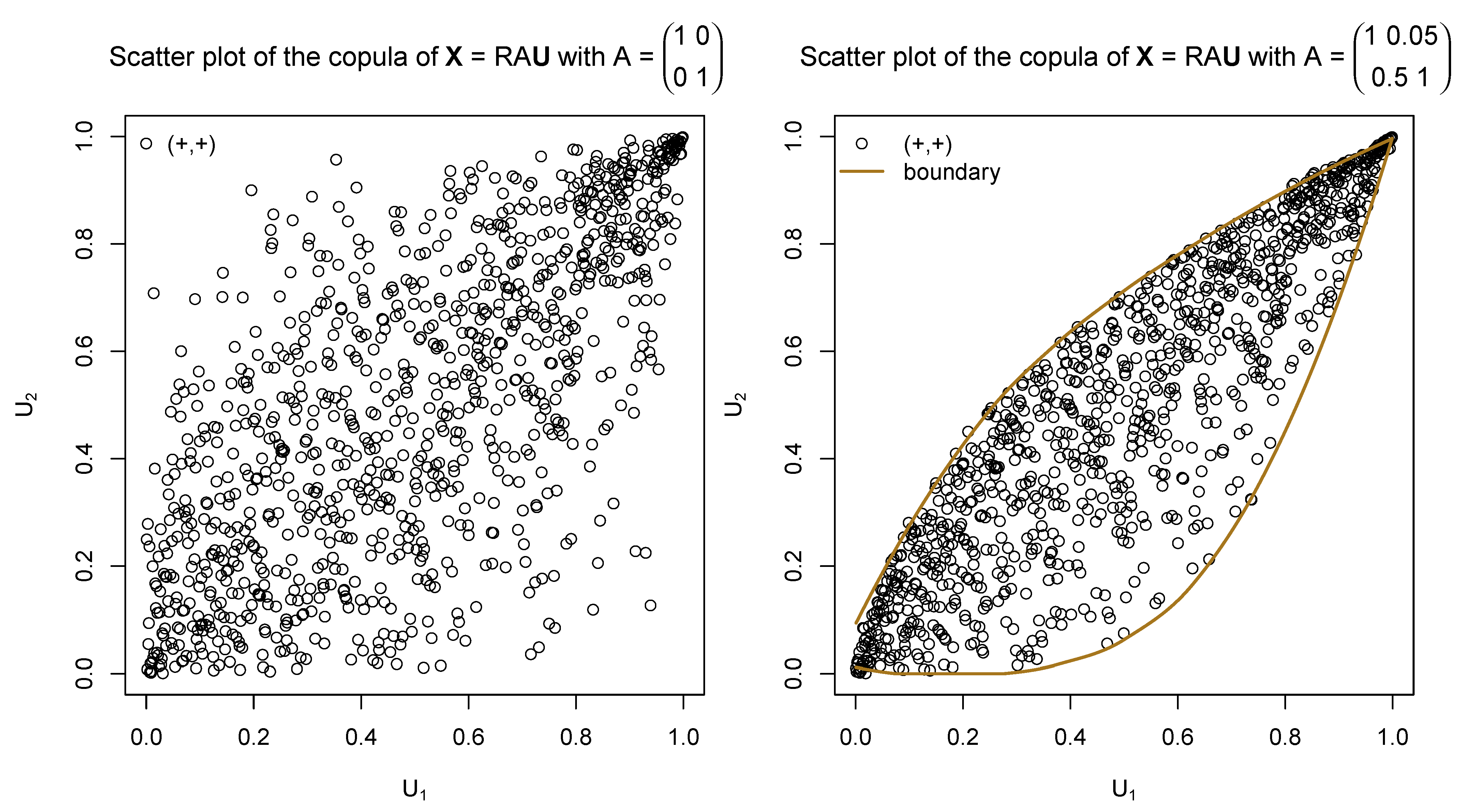Proof. First, note that, for some
,
If
and
, then
Similarly, if
and
, we can interchange the role of
and
and obtain
which is as stated in the claim. From now on, assume
and
, and let
. Then,
In the remaining part of the proof, we rewrite this expression to obtain the form as stated. Using
and
, multiplying out the terms, and noting that
for all except the last term
D (which easily follows from the bounds in the other indicators), we obtain that
where
Basic calculations show that
so that
with
In addition,
implies that
, with
As for
B, we can decompose
into
with
Furthermore,
can be written as
, where
It is easy to see that
. Finally, we can multiply with indicators that
and obtain that
By first taking out
and consecutively pulling together the terms, we obtain that
which, by a basic calculation, leads to the claim as stated. □
The following lemma is an auxiliary result, which is also used in the proof of Theorem 1.
We can now address the proof of Theorem 1.
Proof of Theorem 1. We consider several cases.
Case 1: and .
The fraction in the integrand can be written as
and thus the whole integral as
, with
By distinguishing the cases
,
, and
, we obtain that
Note that, if
, then
. This implies that
By splitting up
F in a similar fashion, we obtain that
Distinguishing the cases of different sign of
in the last integral leads to
Note that the first and third integrald on the right-hand side of the last equation can be pulled together. In addition, note that the second integral can be written as
Applying Lemma A1 leads to
Recalling that the result is , we obtain the form as claimed.
Case 2: and .
This case directly follows from Case 1 by interchanging and , as well as and .
Case 3: and .
Since
, let us first consider the integrand. By Proposition A1, we have that
where
It is straightforward to check that
We now consider four different cases.
Case 3.1: and
. Condition (
A1) and the last equivalence imply that
so that
Furthermore,
implies that
so that
Similarly, we obtain that
Summarizing the terms leads to
Since
and
, we have
Consider the case
. If
, then
, so that
. If
and
, then our above assumptions imply that
, a contradiction. Thus,
if
. Similarly,
if
. This implies that
For
, we have
if
. Thus, for
, we have that
Integrating the terms now leads to
Case 3.2: and .
It is straightforward to check that, in this case,
so that
For
B, note that
and
imply that
. For
,
. Furthermore,
, and
imply that
. Therefore,
Note that, in our case here,
because
but the right-hand side is less than or equal to
. In addition, if
, we have that
, because, otherwise (
), we have
, which then leads to
, a contradiction (note that
). This implies that
Case 3.3: and .
Let
. If
, then
, so
. If
, then
, thus
and therefore
. This implies that
and thus that
, so this indicator drops out of the term
A. In addition, note that
implies
for
. Hence, the corresponding indicator in the term
A is also always one. We therefore obtain that
By considering the cases of different signs for
, we can write the term
B as
If
and
, then
, so
. By summarizing the indicators, this yields
Since
if
and
, it follows that
Note that the indicator function
drops out, since, if
and
, then
. The second summand of indicators completely vanishes, since, if
and
, then
implies
. If
, the contradiction
follows. We thus obtain that
Pulling the terms together, we obtain that
Distinguishing the cases
and
, we obtain that
Note that
and
. We show next that
. To this end, let
. If
, then
implies that
and thus
. If
, then a contradiction follows immediately. Otherwise, we see that
. This yields
in contradiction to the assumption that
. If
, then
yields a contradiction immediately. Therefore,
and hence
. Similarly, if
and
, we show that
. To this end, let
. Then,
, so that
, and thus
. The case
directly leads to a contradiction. If
, then
, which implies that
. As above, this leads to a contradiction to the assumption that
. Thus,
. Plugging in these relations and summarizing the terms, we obtain that
Integrating the terms now leads to
Case 3.4: and .
Interchanging the roles of
,
and
,
, we obtain that
□
Finally, here is the proof of Proposition 2.
Proof of Proposition 2. (1) Recall that
for
as in (
4). Then,
Under the given assumptions, note that the distribution of
is supported in the first quadrant, the marginal survival functions are equal (denoted by
), and, for
, we have by Corollary 1 that
Therefore, we obtain that
Let .
Since and ψ is non-increasing, for all . Furthermore, there exists an such that the numerator of (A4) is zero but the denominator is greater than zero for all . Hence .
If
, applying l’Hôpital’s Rule leads to
Dividing by
and using regular variation, we obtain that
Now, consider
and note that
Using (A2) and (A3), and proceeding similarly as above (with regular variation at 0), one obtains as stated.
(2) Under the given assumptions, using Corollary 1, we obtain that
If
, then
. If
, then l’Hôpital’s Rule and regular variation imply that
Now, consider
and note that the margins live on
. Similar to above, we obtain that
which is easily seen to be 0.
□














